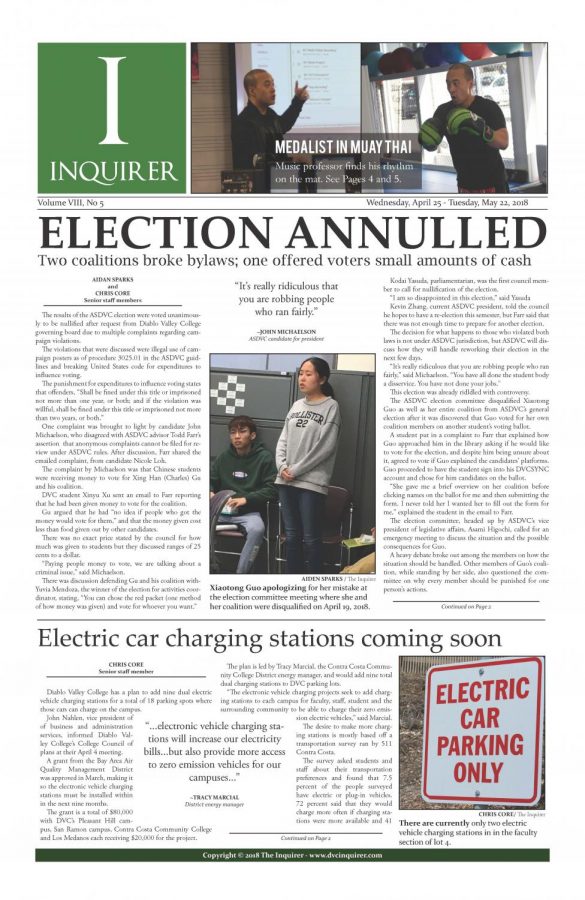Professor Adam Bessie has taught English courses for 18 years, but this fall at Diablo Valley College brought a problem he had never seen before: many of his supposed students were not real people.
For years, community colleges across California have been plagued by fraudulent enrollments — sometimes called “ghost students” or “Pell runners” — where scammers use fake or stolen identities to sign up for classes they will never attend as part of a scheme to steal financial aid (such as Pell Grants) or commit other cybercrimes.
This type of fraud rose during the pandemic, when academic life shifted to an online environment. Now, in the Fall 2024 semester, it has exploded into full view.
“I know it has existed elsewhere, but it’s new to me,” said Bessie, who was caught unaware about the crisis when he returned to the classroom after summer break. “I learned through an email from administration that it existed, and then immediately my first thought [was], ‘Can I trust the enrollments?'”
The email, sent to DVC faculty on Aug. 22, warned of “an uptick in fraudulent enrollments” and told instructors of online and hybrid courses to drop students who did not participate within the first few days of class.
DVC administrators stated in the email that they “have worked carefully behind the scenes” to clear out fake enrollments, but the scammers’ methods have become increasingly sophisticated.
Although students who do not participate in online courses can be dropped, some ghost students have reportedly posted in Canvas, making them harder to spot.
However, in many cases they do not respond to direct questions from their professors or show up to in-person sessions of hybrid courses, raising questions about who, or more precisely what, is behind the accounts and what purpose they serve.
Joseph Gorga, vice president of equity and instruction at DVC, told The Inquirer that as of Sept. 13, the college had dropped more than 1,400 fake enrollments this semester — many of which were initially enrolled as ghost students at Los Medanos College or Contra Costa College before signing up for multiple classes at DVC.
Gorga said many fake enrollments are ideally caught by the state, because community college applicants must first pass through the statewide application site CCCApply, and its verification processes, before enrolling in specific colleges and courses.
“The state has some filters that they [use] to try to filter out applications first,” said Gorga, “then DVC looks for certain things” in its own capacity to ferret out ghost students.
Gorga said he could not give specifics about what the school’s filters look for without “keying off” the fraudsters in the process.
According to CalMatters, potential red flags of fake enrollments include unusual email domains, Social Security numbers stolen from retirees, suspicious home addresses (such as vacant lots) and an unexplained spike in enrollments within a short amount of time.
Bessie also reported seeing strange “double names,” such as “Jonathon Jonathon,” fueling suspicions of AI-generated profiles.
The California Community Colleges (CCC) Chancellor’s Office said in a statement that they have many approaches to combating fraud at the statewide level, including stricter identity verification procedures, updated fraud-detection technology, enhanced training and support for colleges, and monthly fraud reports from each college.
“Successful financial aid fraud is rare relative to the total volume of student aid distributed,” said Melissa Villarin, an information officer with CCC.
However, “currently we are seeing about 25 percent of application activity being flagged as suspected fraud,” she said, and “this is up from about 20 percent two years ago.”
“Our systems are becoming more effective at detecting fraud, even as the attempts become more sophisticated.”
Most fraud attempts are stopped at an early stage before the scammers can apply for financial aid, added Villarin. Of the $3.3 billion in financial aid that was distributed by California community colleges in 2022-2023, less than 0.1 percent was deemed fraudulent.
The CCC Chancellor’s Office did not confirm that fraudsters have specifically been using AI, or what Villarin termed “so-called ‘bots,'” to enroll in classes. She said enrollment fraud “is perpetuated not by machines, but by criminals taking advantage of students and taxpayers.”
But instructors like Bessie are still left with many unanswered questions about the pervasive scam.
“I didn’t know the nature of the phrase ‘fraudulent enrollment,'” said Bessie. “Like, what is it? Is it AI? Is it actual humans? Where is it coming from? What is the scam?”
He added that his biggest concern is that real students might be “deterred from classes or lose [class] space in a time when there’s heavy demand,” which may make them more likely to drop out of college entirely.
“From an equity and student success standpoint, that’s a real, serious problem,” he said.












































































Donna Smith • Oct 7, 2024 at 10:58 pm
Thank you Inquirer for a timely article on this very perplexing issue.
I have a Journalism short-term Hybrid course this fall, that had 3 students enrolled a month before it was to begin. That number jumped to over 20 overnight. A week or so later those students disappeared from the roster, but returned to nearly fill the class again soon after. At the start of this short term, there were 25 students on the opening day roster but only 8 students came to the first class. Again, the ghost students disappeared from the roster, but the confusion and time needed to prepare for a nearly-full class meant more prep-time, a change of rooms and then concern over the course continuing. This must be equally unsettling for students trying to join a course that appears full, but is not.
j • Apr 25, 2025 at 9:28 am
Classes which are full and have full waitlist cannot be joined at all.